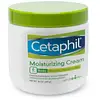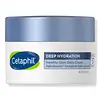What's inside
What's inside
 Key Ingredients
Key Ingredients

 Benefits
Benefits

 Concerns
Concerns

 Ingredients Side-by-side
Ingredients Side-by-side

Water
Skin ConditioningGlyceryl Polymethacrylate
Propylene Glycol
HumectantPetrolatum
EmollientDicaprylyl Ether
EmollientPEG-5 Glyceryl Stearate
EmulsifyingGlycerin
HumectantDimethiconol
EmollientCetyl Alcohol
EmollientPrunus Amygdalus Dulcis Oil
Skin ConditioningAcrylates/C10-30 Alkyl Acrylate Crosspolymer
Emulsion StabilisingTocopheryl Acetate
AntioxidantPhenoxyethanol
PreservativeBenzyl Alcohol
PerfumingDisodium EDTA
Sodium Hydroxide
BufferingLactic Acid
BufferingWater, Glyceryl Polymethacrylate, Propylene Glycol, Petrolatum, Dicaprylyl Ether, PEG-5 Glyceryl Stearate, Glycerin, Dimethiconol, Cetyl Alcohol, Prunus Amygdalus Dulcis Oil, Acrylates/C10-30 Alkyl Acrylate Crosspolymer, Tocopheryl Acetate, Phenoxyethanol, Benzyl Alcohol, Disodium EDTA, Sodium Hydroxide, Lactic Acid
Water
Skin ConditioningDicaprylyl Carbonate
EmollientGlycerin
HumectantCaprylic/Capric Triglyceride
MaskingGlyceryl Stearate Citrate
EmollientCetearyl Alcohol
EmollientNiacinamide
SmoothingAnhydroxylitol
HumectantButyrospermum Parkii Oil
EmollientCitric Acid
BufferingGlobularia Alypum Leaf Extract
Skin ConditioningHydrolyzed Hyaluronic Acid
HumectantPanthenol
Skin ConditioningPantolactone
HumectantPhenoxyethanol
PreservativeSodium Benzoate
MaskingSodium Polyacrylate
AbsorbentSqualane
EmollientTocopherol
AntioxidantXylitol
HumectantXylitylglucoside
HumectantWater, Dicaprylyl Carbonate, Glycerin, Caprylic/Capric Triglyceride, Glyceryl Stearate Citrate, Cetearyl Alcohol, Niacinamide, Anhydroxylitol, Butyrospermum Parkii Oil, Citric Acid, Globularia Alypum Leaf Extract, Hydrolyzed Hyaluronic Acid, Panthenol, Pantolactone, Phenoxyethanol, Sodium Benzoate, Sodium Polyacrylate, Squalane, Tocopherol, Xylitol, Xylitylglucoside
 Reviews
Reviews

Ingredients Explained
These ingredients are found in both products.
Ingredients higher up in an ingredient list are typically present in a larger amount.
Glycerin is already naturally found in your skin. It helps moisturize and protect your skin.
A study from 2016 found glycerin to be more effective as a humectant than AHAs and hyaluronic acid.
As a humectant, it helps the skin stay hydrated by pulling moisture to your skin. The low molecular weight of glycerin allows it to pull moisture into the deeper layers of your skin.
Hydrated skin improves your skin barrier; Your skin barrier helps protect against irritants and bacteria.
Glycerin has also been found to have antimicrobial and antiviral properties. Due to these properties, glycerin is often used in wound and burn treatments.
In cosmetics, glycerin is usually derived from plants such as soybean or palm. However, it can also be sourced from animals, such as tallow or animal fat.
This ingredient is organic, colorless, odorless, and non-toxic.
Glycerin is the name for this ingredient in American English. British English uses Glycerol/Glycerine.
Learn more about GlycerinPhenoxyethanol is a preservative that has germicide, antimicrobial, and aromatic properties. Studies show that phenoxyethanol can prevent microbial growth. By itself, it has a scent that is similar to that of a rose.
It's often used in formulations along with Caprylyl Glycol to preserve the shelf life of products.
Water. It's the most common cosmetic ingredient of all. You'll usually see it at the top of ingredient lists, meaning that it makes up the largest part of the product.
So why is it so popular? Water most often acts as a solvent - this means that it helps dissolve other ingredients into the formulation.
You'll also recognize water as that liquid we all need to stay alive. If you see this, drink a glass of water. Stay hydrated!
Learn more about Water